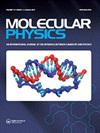掺钠镁簇阳离子的结构演化、稳定性、电子和键合性能
IF 1.8
4区 化学
Q4 CHEMISTRY, PHYSICAL
引用次数: 0
摘要
摘要通过CALYPSO编码和DFT计算的协同结合,研究了双金属钠掺杂镁簇阳离子NaMgn+(n= 2-12)。结果表明,namn +的最低能结构表现为线性、平面、三角金字塔、五边形金字塔和三角棱镜结构。该结构可以描述为小尺寸纯Mg簇的替代几何结构。从n = 9开始,主导结构转变为基于三角形棱柱的构型。像阴离子和中性的纳米锰簇一样,Na原子倾向于纳米锰框架的外围区域。稳定性研究表明NaMg4+和NaMg10+是最稳定的簇,这可能得益于它们的闭壳电子结构。结合性质分析表明,在NaMg4+和NaMg10+簇中,Mg-Mg相互作用强于Na-Mg相互作用。这是因为在Mg-Mg区形成共价键,而在Na-Mg区没有电子密度聚集。关键词:DFTCALYPSONaMgn+集群结构电子属性披露声明作者未报告潜在的利益冲突。项目资助:陕西省自然科学基础研究计划项目(批准号2023-JC-YB-464)。本文章由计算机程序翻译,如有差异,请以英文原文为准。
Structural evolution, stability, electronic and bonding properties of sodium-doped magnesium cluster cations
AbstractBimetallic sodium-doped magnesium cluster cations, NaMgn+(n= 2–12), have been investigated through a synergetic combination of the CALYPSO code and DFT calculations. The results reveal that the lowest-energy structures of NaMgn+ exhibit linear, planar, triangular pyramid, pentagonal pyramid, and triangular prism topologies. The structures can be described as a substituted geometry of pure Mg clusters at the small size. Starting from n = 9, the dominant structures transform into a triangular prism-based configuration. Like anionic and neutral NaMgn clusters, the Na atom prefers the peripheral regions of the Mgn framework. Stability studies indicate NaMg4+ and NaMg10+ to be the~most stable clusters, which may benefit from their closed-shell electron structures. Analysis of the bonding nature shows stronger Mg-Mg interaction than the Na-Mg interaction in the NaMg4+ and NaMg10+ clusters. The reason is that covalent bonds are formed in the Mg-Mg regions, while there is no aggregation of electron density in the Na-Mg regions.KEYWORDS: DFTCALYPSONaMgn+ clustersstructureselectronic properties Disclosure statementNo potential conflict of interest was reported by the author(s).Additional informationFundingThis work was supported by the Natural Science Basic Research Plan in Shaanxi Province of China (grant number 2023-JC-YB-464).
求助全文
通过发布文献求助,成功后即可免费获取论文全文。
去求助
来源期刊

Molecular Physics
物理-物理:原子、分子和化学物理
CiteScore
3.60
自引率
5.90%
发文量
269
审稿时长
2 months
期刊介绍:
Molecular Physics is a well-established international journal publishing original high quality papers in chemical physics and physical chemistry. The journal covers all experimental and theoretical aspects of molecular science, from electronic structure, molecular dynamics, spectroscopy and reaction kinetics to condensed matter, surface science, and statistical mechanics of simple and complex fluids. Contributions include full papers, preliminary communications, research notes and invited topical review articles.
 求助内容:
求助内容: 应助结果提醒方式:
应助结果提醒方式:


